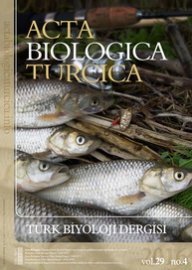Reproductive biology of female common sole Solea solea (Linnaeus, 1758) in the southern Aegean Sea
Abstract
This study is on reproduction study about common sole in Turkey. Reproduction studies are useful for fishery management. So, our aim was to gathering information about common sole reproduction strategy. Fishing operations were conducted between October 2013 – November 2015 in Güllük Bay and Boğaziçi lagoon which are on the south-west coast of Turkey. We used beach seine and trammel nets with different mesh sizes (52-56-64-80-90 mm) to obtain various length classes. Ovulation type, fecundity and gonadosomatic index of common sole were determined. We also performed gonadal sectioning to determine oocyte development stages. We observed asynchronous ovulation in egg production strategy. Fecundities differed between 13.924 and 341.479 in number. We found a linear correlation between total length and fecundity. Length at first maturity was determined as 15.4 cm. Study findings are useful for common sole fishery management. These findings may also be useful for further aquaculture applications on common sole.
Keywords
Full Text:
PDFReferences
Abookire A.A., Macewicz B.J. 2003. Latitudinal variation in reproductive biology and growth of female Dover sole (Microstomus pacificus) in the North Pacific, with emphasis on the Gulf of Alaska stock. Journal of Sea Research 50: 187– 197. DOI: https://doi.org/10.1016/S1385-1101(03)00062-5
Anguis V., Canavate J.P. 2005. Spawning of captive Senegal sole (Solea senegalensis) under a naturally fluctuating temperature regime, Aquaculture 243: 133–145.
Bolle L.J., de Jong C.A.F., Bierman S.M., van Beek P.J.G., van Keeken O.A., Wessels P.W., van Damme C.J.G., Winter H.V., de Haan D., Dekeling R.P.A. 2012. Common Sole Larvae Survive High Levels of Pile-Driving Sound in Controlled Exposure Experiments. PLoS ONE 7 (3): e33052. DOI: https://doi.org/10.1371/journal.pone.0033052
Culling C.F.A. 1963. Handbook of Histopathological Techniques. 4th edition. London: Butterworths. 726p.
Deniel C. 1981. Les poissons plats (Teleostei, Pleuronectiformes) en Baie de Douarnenez. Reproduction, croissance en migration des Bothidae, Scophthalmidae, Pleuronectidae and Soleidae. Universite de Bretagne Occidentale, Brest, France.
Diopere E., Maes G.E., Komen H., Volckaert F.A.M., Groenen M.A.M. 2014. A Genetic Linkage Map of Sole (Solea solea): A Tool for Evolutionary and Comparative Analyses of Exploited (Flat)Fishes. PLoS ONE 9 (12): e115040. DOI: https://doi.org/10.1371/journal.pone.0115040
Ganias K., Lowerre-Barbieri S.K., Cooper W. 2015. Understanding the determinate–indeterminate fecundity dichotomy in fish populations using a temperature dependent oocyte growth model. Journal of Sea Research 96: 1-10. DOI: https://doi.org/10.1016/j.seares.2014.10.018
García-López A., Couto E., Canario A.V., Sarasquete C., Martínez-Rodríguez G. 2007. Ovarian development and plasma sex steroid levels in cultured female Senegalese sole Solea senegalensis. Comparative Biochemistry and Physiology Part A: Molecular & Integrative Physiology 146 (3): 342–354. DOI: https://doi.org/10.1016/j.cbpa.2006.11.014
Gibson R.N., Stoner A.W., Ryer C.H. 2015. The behaviour of flatfishes. In: Gibson R.N., Nash R., Geffen A., Van der Veer H. (Ed.) Flatfishes: biology and exploitation. 2nd ed. Oxford, Blackwell Publishing. pp 314-245.
Horwood J.W., Greer Walker M. 1990. Determinacy of Fecundity in Sole (Solea Solea) from The Bristol Channel. Journal of the Marine Biological Association of the United Kingdom 70: 803–813. DOI: https://doi.org/10.1017/S0025315400059075
Miller J.M., Burke J.S., Fitzhugh G.R. 1991. Early life history patterns of Atlantic North American latish: likely (and unlikely) factors controlling recruitment. Netherlands Journal of Sea Research 27: 261–275. DOI: https://doi.org/10.1016/0077-7579(91)90029-Z
Morgan M.J., Colbourne E.B. 1999. Variation in maturity at-age and size in three populations of American plaice. ICES Journal of Marine Science 56: 673e688. DOI: https://doi.org/10.1006/jmsc.1999.0487
Otero M., Garrabou J., Vargas M. 2013. Mediterranean Marine Protected Areas and climate change: A guide to regional monitoring and adaptation opportunities. Malaga, Spain. 52p.
Rijnsdorp A.D., van Damme C.J.G., Witthames R.P. 2015. Ecology of reproduction. In: Gibson R.N., Nash R., Geffen A., Van der Veer H. (Ed.) Flatfishes: biology and exploitation, 2nd ed. Oxford, Blackwell Publishing. Pp 101-131.
Saleh H.H.E., Allam S.M., Abou-Zied R.M., Mohammed R.A., Safaa S.A., Aljilany, S.S.A. 2016. Effect of diet type and stocking density on growth performance and blood parameters of the Egyptian sole (Solea aegyptiaca Chabanaud, 1927). Abbassa International Journal For Aquaculture 9 (1): 84–134.
Seafish 2013. Responsible sourcing guide – Dover sole. Version 7, May 2013. http://www.seafish.org/media/publications/SeafishResponsibleSourcingGuide_Doversole_201305.pdf
Shafi S. 2012. Study on fecundity and GSI of Carassius carassius (Linneaus, 1758-introduced) from Dal Lake Kashmir. Journal of Biology, Agriculture and Healthcare 2(3): 68-75.
Sims D.W., Wearmouth V.J., Genner M.J., Southward A.J., Hawkins S.J. 2004. Low-temperature-driven early spawning migration of a temperate marine fish. Journal of Animal Ecology 73:333–341.
Teixeira T.F.A. 2007. Genetic diversity and population structure of Solea solea and Solea senegalensis and its relationships with life history patterns. Universidade de Lisboa, Lisboa, Portugal.
Turkish State Meteorological Service (TSMS) 2018. Analysing of Aegean Sea temperature. https://www.mgm.gov.tr/FILES/resmi-istatistikler/denizSuyu/Ege-DenizSuyu-Sicakligi-Analizi.pdf
Türkmen M. 2003. Investigation of Some Population Parameters of Common Sole, Solea solea (L., 1758) from İskenderun Bay. Turkish Journal of Veterinary and Animal Sciences 27: 317–323.
Witthames P.R., Greer Walker M., Dinis M.T., Whiting C.L. 1995. The geographic variation in the potential annual fecundity of Dover sole Solea solea (L.) from European shelf waters during 1991. Netherlands Journal of Sea Research 34: 45–58. DOI: https://doi.org/10.1016/0077-7579(95)90013-6
Zaitsev Y., Öztürk B. 2001. Exotic Species in the Aegean, Marmara, Black, Azov and Caspian Seas. Istanbul, Turkey: Turkish Marine Research Foundation. 265p.
Refbacks
- There are currently no refbacks.

